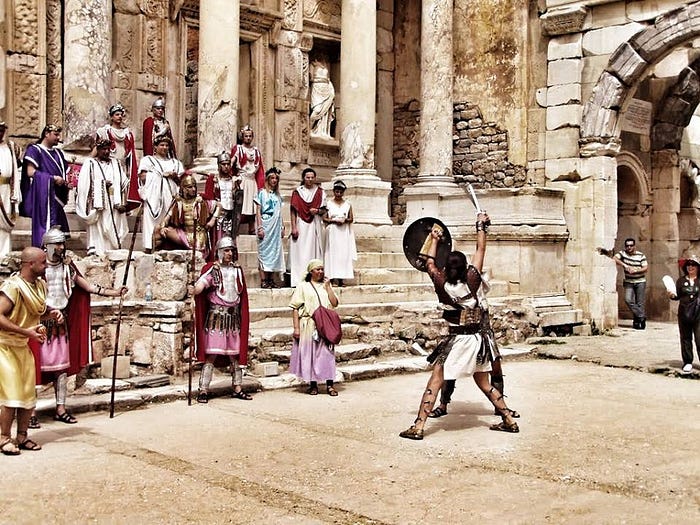The rise and fall of ancient Ephesus, Turkey — Ephesus History

According to the old legends, Ephesus was founded by the female warriors known as the Amazons. The name of the city is thought to have been derived from “APASAS”, the name of a city in the “KINGDOM OF ARZAWA” meaning the “city of the Mother Goddess”. Ephesus was inhabited from the end of the Bronze Age onwards, but changed its location several times in the course of its long history in accordance with habits and requirements. Carians and Lelegians are to be have been among the city’s first inhabitants. Ionian migrations are said to have begun in around 1200 B.C. According to legend, the city was founded for the second time by Androclus, the son of Codrus, king of Athens, on the shore at the point where the CAYSTER (Küçük Menderes) empties into the sea, a location to which they had been guided by a fish and a wild boar on the advice of the soothsayers. The Ionian cities that grew up in the wake of the Ionian migrations joined in a confederacy under the leadership of Ephesus. The region was devastated during the Cimmerian invasion at the beginning of the 7th century B.C. Under the rule of the Lydian kings, Ephesus became one of the wealthiest cities in the Mediterranean world. The defeat of the Lydian King Croesus by Cyrus, the King of Persia, prepared the way for the extension of Persian hegemony over the whole of the Aegean coastal region. At the beginning of the 5th century, when the Ionian cities rebelled against Persia, Ephesus quickly dissociated itself from the others, thus escaping destruction.
Ephesus remained under Persian rule until the arrival of Alexander the Great in 334 B.C., when it entered upon a fifty year period of peace and tranquillity. Lysimachus, who had been one of the twelve generals of Alexander the Great and became ruler of the region on Alexander’s death, decided to embark upon the development of the city, which he called Arsineia after his wife Arsinoe. He constructed a new harbour and built defence walls on the slopes of the Panayır and Bülbül Mts., moving the whole city 2.5 km to the south-west. Realising, however, that the Ephesians were unwilling to leave their old city, he had the whole sewage system blocked up during a great storm, making the houses uninhabitable and forcing the inhabitants to move. In 281 B.C. the city was re-founded under the old name of Ephesus and became one of the most important of the commercial ports in the Mediterranean.
In 129 B.C. the Romans took advantage of the terms of the will left by Attalos, King of Pergamon, by which they were bequathed his kingdom, to incorporate the whole region into the Roman Empire as the province of Asia. Ancient sources show that at this time the city had a population of 200,000. In the 1st century B.C. the heavy taxes imposed by the Roman government led the population to embrace Mithridates as their savior and to support him in his mutiny against Roman authority and in 88 B.C. a massacre was carried out of all the Latin speaking inhabitants of the city, which was then stormed and sacked by a Roman army under Sulla, It was from the reign of Augustus onwards that the buildings we admire today were constructed. According to documentary sources, the city suffered severe damage in an earthquake in 17 A.D. After that, however, Ephesus became a very important centre of trade and commerce. The historian Aristio describes Ephesus as being recognised by all the inhabitants of the region as the most important trading centre in Asia. It was also the leading political and intellectual centre, with the second school of philosophy in the Aegean. From the 1st century onwards, Ephesus was visited by Christian disciples attempting to spread the Christian belief in a single God and thus forced to seek refuge from Roman persecution. Besides enjoying a privileged position between East and West coupled with an exceptionally fine climate, the city owed its importance to its being the centre of the cult of Artemis.
For the Christians, the city, with its highly advanced way of life, its high standard of living, the variety of its demographic composition and its firmly rooted polytheistic culture, must have presented itself as an ideal pilot region… From written sources we learn that St Paul remained in the city for three years from 65 to 68, and that it was here that he preached his famous sermons calling upon the hearers to embrace the faith in. one God. He taught that God had no need of a house made with human hands and that he was present in all places at all times. This was all greatly resented by the craftsmen who had amassed great wealth from their production of statues of Artemis in gold, silver or other materials. A silversmith by the name of Demetrius stirred up the people and led a crowd of thousands of Ephesians to the theatre, where they booed and stoned Paul and his two colleagues, chanting “Great is Artemis of the Ephesians! Great is Artemis of the Ephesians!” So turbulent was the crowd that Paul and his companions escaped only with great difficulty. From his Epistles to the communities it would appear that Paul spent some time as a prisoner in Ephesus.
Legend has it that St John the Evangelist came to Ephesus with the Virgin Mary in his care. Some also say that it was here that he wrote his Gospel and was finally buried. In 269 Ephesus and the surrounding country was devastated by the Goths. At that time there was still a temple in which the cult of Artemis was practised. In 381, by order of the Emperor Theodosius, the temple was closed down, and in the following centuries it lay completely abandoned, serving as a quarry for building materials.
The situation of the city, which had given it its privileged geographical position, was also the cause of its decline and fall. The prosperity of the city had been based on its possession of a sheltered natural harbour, but by the Roman period ships reached the harbour to the west of Mt Pion 1.5 km from the Temple of Artemis through a very narrow and difficult channel. The cause of this was the Meander (Cayster) River, which emptied into the Aegean a little to the west of the city of Ephesus, where it created a delta formed by the alluvium carried down by the river over thousands of years. By the late Byzantine era the channel had been so silted up as to be no longer usable. The sea gradually receded farther and farther, while the marshy lands around the harbour gave rise to a number of diseases, such as malaria. The new outlook that had arisen with the spread of Christianity led to the gradual abandonment of all buildings bearing witness to the existence of polytheistic cults and the construction in their place of Christian churches. In the year 431 the third Ecumenical council took place in Ephesus.
Emperor Theodosius convoked another council in Ephesus in 449, which came to be known as the “robber council”. From the 6th century onwards the Church of St John was an important place of pilgrimage, and Justinian took measures to protect it by having.the whole hill on which it stood surrounded by defence walls. Shortly afterwards, the Church of the Virgin and other places of worship were destroyed and pillaged in Arab raids. In the 7th century the city was transferred to the site now occupied by the town of Selçuk and during the Byzantine era Ephesus grew up around the summit of Mt Ayasuluğ. The city enjoyed its last years of prosperity under the Selçuk Emirate of the Aydınoğulları. During the Middle Ages the city ceased to function as a port.
By the 20th century the silt carried down by the Meander had extended the plain for a distance of 5 km.

Roman Bourse or double church of the Virgin Mary
This Roman building is dated to the 2nd century A.D. It is a three-aisled church measuring 265 x 90 m. Until its conversion into a church in the 4th century A.D. it performed a secular function. Its proximity to the harbour allowed important commercial goods to be marketed here without the necessity of transporting them into the city itself. The Byzantine church was added to the western side.
Austrian archaeologists are engaged here in endeavours to locate the site of the bishop’s palace. The church itself housed the third Ecumenical council at which the divine character of Christ and the Virgin Mary was discussed. Nestorius (380–451), the founder of the school of Antioch and the Patriarchate of Istanbul put forward the view opposing the divine nature of Christ and regarding Mary not as the mother of God but as the mother of a human being.
The Alexandrian school on the other hand, put foward the more mystical, more traditional view that Mary was the mother of God and in the end Nestorius was exiled. Ephesus thus became one of the most important centres of the Christian world and the reverence for the Virgin Mary at Ephesus was greatly increased.
The so called Robber Council of 449 accepted the thesis of the purely divine nature of Christ in which his human character was completely ignored. This doctrine was later in the East as Monophysitism.

Terrace Houses
Some of these houses were first opened to the public in 1985, when restoration work was undertaken. It has been proved that this sector was used for urban development from the 1st century B.C. onwards. The houses were the property of various owners until the 7th century. The district enjoyed its peak of prosperity between the 2nd and 4th centuries. These were one-storey houses occupied by wealthy citizens or priests of noble lineage and composed of spacious rooms grouped around an open-air courtyard, the largest being used as reception and dining-room. In addition to kitchens and cellar a large number of bed-rooms have been unearthed. Water was supplied by fountains surrounded by mosaics. Some of the walls reach a height of 4 m. and stairs leading to the upper storeys have also been unearthed. For flooring, mosaics were preferred to marble pavements but marble was frequently employed around the thresholds. Wall decorations consist mainly of painting on plaster. A visit to the terrace houses should be supplemented by a visit to the Archaeological Museum in Selcuk in which a very rich collection of murals, furniture and utensils are exhibited.
“These are municipal residences of prominent and wealthy Ephesian citizens, whose houses served as spaces in which business was conducted and where clients and guests were received, and which, in short, promoted the prestige of their owners.”
– Dr. Sabine Ladstätter, head of the Ephesus Project.








